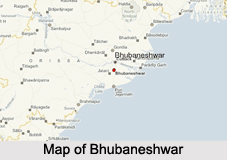 Bhubaneshwar is the modern capital of Odisha in independent India. It is known as "Temple Metropolis of India". The temples of Bhubaneshwar bear witness to the comprehensive history of the Orissan style of temple architecture. Bhubaneshwar is known for its architecture and ancient temples.
Bhubaneshwar is the modern capital of Odisha in independent India. It is known as "Temple Metropolis of India". The temples of Bhubaneshwar bear witness to the comprehensive history of the Orissan style of temple architecture. Bhubaneshwar is known for its architecture and ancient temples.
Location of Bhubaneshwar
Bhubaneshwar is located in the Khordha District of Odisha.
History of Bhubaneshwar
The history of Bhubaneshwar can be traced back to 2000 years. Emperor Kharavela established his capital in Sisupalgarh, which is located on the periphery of the city. The inscriptions on "Udaygiri Caves" and "Khandagiri Caves" bear evidence to the antiquity of the place. Its many temples, displaying every phase of Orissan architecture were built in the 7th-16th century. It was in the 11th Century that the Lingaraj Temple of old Bhubaneshwar was built.
Just 8km from Bhubaneshwar is situated Dhauli, the plains that bore witness to the gruesome war waged on Kalinga by the Mauryan emperor Ashoka. It was here that King Ashoka, full of remorse after the Kalinga War in 261 BC, renounced his ferocious war and turned to Buddhism. Ashoka erected 2 main edicts in Kalinga, one in Dhauli and the other in Jayagarh.
Geography of Bhubaneshwar
 Bhubaneshwar is located in the eastern coastal plains of Odishaon the banks of river Mahanadi. Bhubaneshwar is situated at an altitude of 45m above sea level. The average temperatures range between 15 degree Centigrade in the winter and a maximum of 40 to 45 degree Centigrade in the summer. The average rainfall is 150 cm. It is in June that the city faces southeast monsoons.
Bhubaneshwar is located in the eastern coastal plains of Odishaon the banks of river Mahanadi. Bhubaneshwar is situated at an altitude of 45m above sea level. The average temperatures range between 15 degree Centigrade in the winter and a maximum of 40 to 45 degree Centigrade in the summer. The average rainfall is 150 cm. It is in June that the city faces southeast monsoons.
Demography of Bhubaneshwar
As per the 2011 census of India, Bhubaneshwar had a population of 837,737 of which the number of males was 445,233 and females was 392,504. The effective male literacy was 95.69 %, while female literacy was 90.26 %. The average literacy rate is 93.15 % which is higher than the national average of 74.04 %. About 75,237 were under six. The main language spoken in the city is Oriya; however, Hindi and English are understood by most residents.
Culture of Bhubaneshwar
The cultural heritage is magnificent and people are proud of their culture and heritage. The culture includes the Odissi dance form which is world famous and is well admired as well. Around 7000 temples depict the culture and the history of Bhubaneshwar that has seen times since 2000 years. The people here speak Oriya and bears resembles to the Bengali and Assamese language. Seafood and sweets form a major part Oriya culture.
 Tourism in Bhubaneshwar
Tourism in Bhubaneshwar
Bhubaneshwar is a great religious place that house around 500 temples like the "Lingaraj Temple", "Parashurameswar Temple", "Mukteshwara Temple" etc. The place including Konark and Puri form a holy "Golden Triangle" that is a favorite among the tourists in the eastern part of India. The largest rose garden is another attraction at Bhubaneshwar. The 46m high "Lingaraj Temple" marks the zenith of temple tradition of Bhubaneshwar. It is also an important pilgrimage centre of Hindus who visit the place at least once in their life time. Hundreds of temples can be seen here that are standing since ancient times and boasts of its rich culture and heritage. To the east of Bhubaneshwar are situated the famous "Sun Temple" of Konark and the "Jagannath Temple" of Puri.
Visiting Information
Bhubaneshwar is connected to the major cities of India by means of air and road. Biju Patnaik Airport is the only major airport in the state. Bhubaneshwar is well-connected to other major Indian cities by highway.
Related Articles
Odisha, Indian state
Temples of Odisha
Nature Tourism in Odisha



















